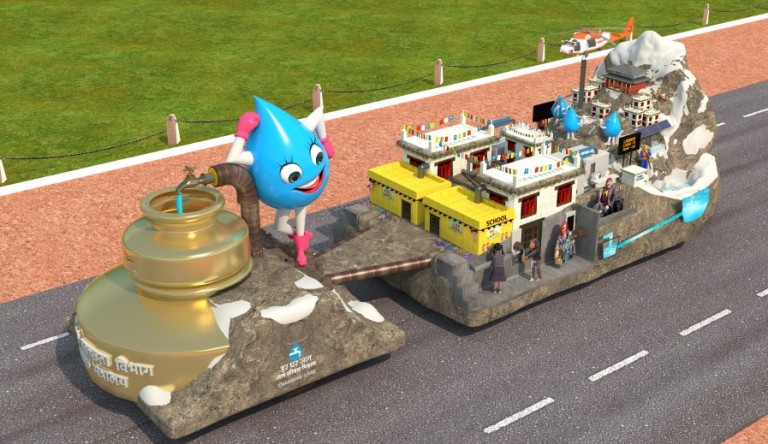Republic Day Tableau: Department of Drinking Water and Sanitation, Ministry of Jal Shakti Jal Jeevan Mission: Changing Lives
Radiance News Service
In a very short span of 29 months since its announcement in August 2019, Jal Jeevan Mission has provided tap water supply to more than 5.61 Crore rural households, 8.4 lakh schools and 8.6 lakh Anganwadi centres in India. At the time of the announcement of the Mission, only 3.23 Crore homes had a tap water supply. The tap water supply to JE-AES affected districts has also gone up from 3% to 40% and in aspirational districts, it has gone from 7.2% to 39%. JJM is removing the drudgery faced in fetching water by women and children for centuries and changing the lives of Crores of people in rural India.
Jal Jeevan Mission is working in the most difficult terrain of the country to provide tap water to communities that face the severity of the climate and lack of drinking water such as in the high altitudes of Ladakh, Himachal Pradesh or Uttarakhand or in deserts of Rajasthan and Gujarat.
Jal Jeevan Mission: Changing Lives tableau depicts how at an altitude of more than 13,000 ft in harsh winter, Jal Jeevan Mission is bringing ease and improving the quality of life of people of Ladakh by providing clean tap water to their homes. There, in winters the maximum temperature during the day remains sub-zero and night temperature falls to -20 degrees Celsius. During extreme winter conditions, providing clean tap water at the doorstep is very challenging as water sources get frozen supply lines to become inoperative, water pipes get frozen and burst. Ladakh has the lowest population density in the country (2.8 person/ sq. km.), villages are scattered and rainfall is scarce. It remains cut off from the rest of the country for a few months in a year due to the closure of passes during winters. This affects the supply of materials badly. Further, most of the water sources are in inaccessible areas, in many areas of Ladakh the water bodies freeze in winters, a lot of labour is required for construction and the help of animals & helicopters is taken to lift and transport the material.
Due to freezing temperatures, in place of regular GI pipe, HDPE pipes are used and main supply lines are laid below the frost line. Wherever pipes come above the frost line, these are encased in 4” dm of glass wool, wood, aluminium jacketing for insulation. Solar power plays an integral part in the water supply chain and ensures the continuous flow of water in the pipeline. There are technical challenges as well to drawing water from frozen water sources.
In such areas where people were forced to dig ice and drink it after melting, now getting clean tap water in the comfort of their homes, schools and Anganwadi. Not only that, through sensor-based IoT systems they know live data about quantity, quality and monitoring of the water supplied. Women in villages have been trained to test the quality of water using Field Test Kits (FTKs)
In the tableau, local women are shown conducting water quality tests by using Field Test Kits (FTKs). JJM has trained more than 8.6 lakh women so far in ensuring clean tap water to homes with the help of FTKs. Water testing laboratories in the country are now open for the public to get their drinking water tested.
A digital board displaying live temperature and real-time data about water supply, chlorination etc. and the progress of the Mission is also presented.


